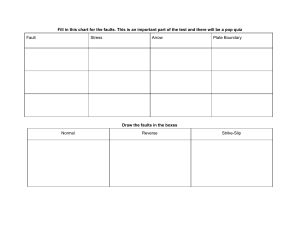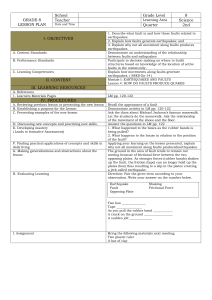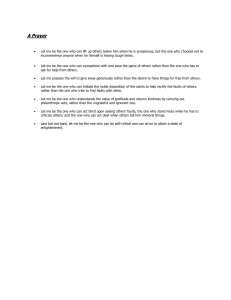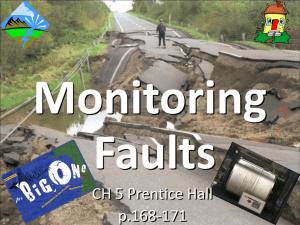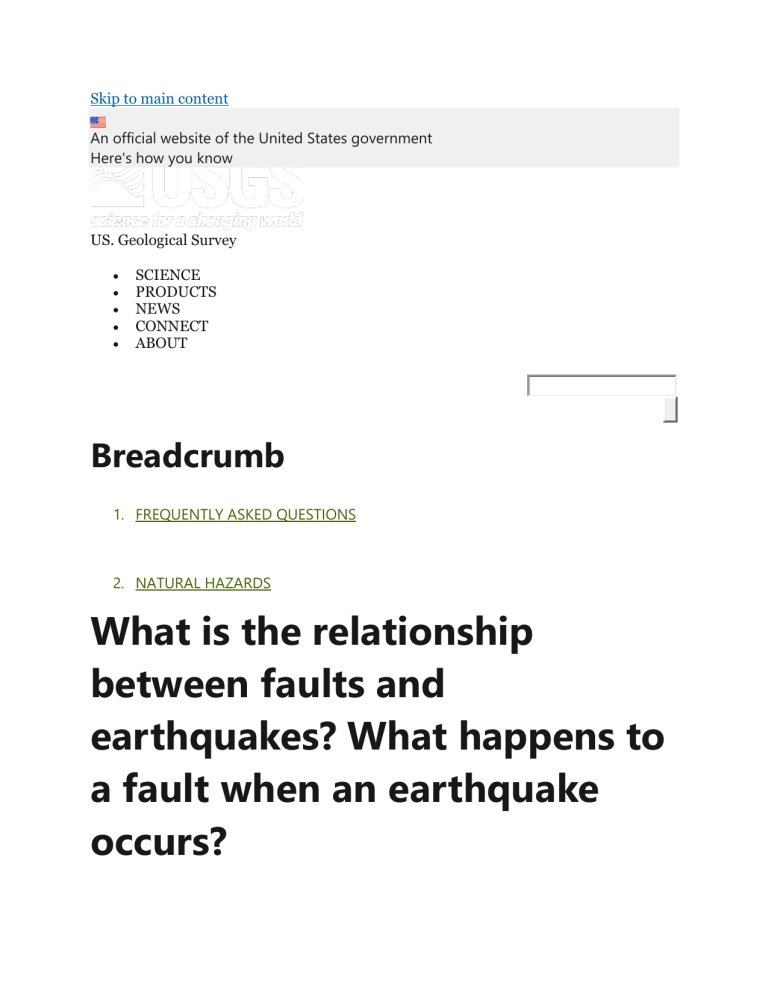
Skip to main content An official website of the United States government Here's how you know US. Geological Survey SCIENCE PRODUCTS NEWS CONNECT ABOUT Latest Earthquakes | Chat Share Label Breadcrumb 1. FREQUENTLY ASKED QUESTIONS 2. NATURAL HAZARDS What is the relationship between faults and earthquakes? What happens to a fault when an earthquake occurs? Earthquakes occur on faults - strike-slip earthquakes occur on strike-slip faults, normal earthquakes occur on normal faults, and thrust earthquakes occur on reverse or thrust faults. When an earthquake occurs on one of these faults, the rock on one side of the fault slips with respect to the other. The fault surface can be vertical, horizontal, or at some angle to the surface of the earth. The slip direction can also be at any angle. Related Content FAQ Multimedia Publications News link What is a fault and what are the different types? A fault is a fracture or zone of fractures between two blocks of rock. Faults allow the blocks to move relative to each other. This movement may occur rapidly, in the form of an earthquake - or may occur slowly, in the form of creep. Faults may range in length from a few millimeters to thousands of kilometers. Most faults produce repeated displacements over geologic time. During an earthquake, the... link What is a "Quaternary" fault? A Quaternary fault is one that has been recognized at the surface and that has moved in the past 1,600,000 years (1.6 million years). That places fault movement within the Quaternary Period, which covers the last 2.6 million years. link Where can I find a fault map of the United States? Is one available in GIS format? An online map of United States Quaternary faults (faults active in the last 1.6 million years which places them within the Quaternary Period) is available via the Quaternary Fault and Fold Database. There is an interactive map application to view the faults online and a separate database search function. KML (Google Earth-type) files and GIS shape files are also available for download from the... link How do I find the nearest fault to a property or specific location? If you are looking for faults in California use: How Close to a Fault Do You Live? (Bay Area Earthquake Alliance) For faults in California and the rest of the United States (as well as the latest earthquakes) use the Latest Earthquakes Map: click on the "Basemaps and Overlays" icon in the upper right corner of the map. check the box for "U.S. Faults". mouse-over each fault to get a pop-up window... link How do I find fault or hazard maps for California? An online map of faults (Quaternary Fault and Fold Database of the United States) that includes California is in the Faults section of the Earthquake Hazards Program website. Choose the Interactive Fault Map, or download KML files and GIS shapefiles from the links on the page. USGS hazard maps, data, and tools for California and other parts of the United States are in the Seismic Hazard Maps and... link Why are there no faults in the Great Valley of central California? The Great Valley is a basin, initially forming ~100 million years ago as a low area between the subducting ocean plate on the west (diving down under the North American plate) and the volcanoes to the east (now the Sierra Nevada mountains). Since its formation, the Great Valley has continued to be low in elevation. Starting about 20 million years ago the tectonics changed in California and instead... link Why are there so many earthquakes and faults in the Western United States? This region of the United States has been tectonically active since the supercontinent Pangea broke up roughly 200 million years ago, and in large part because it is close to the western boundary of the North American plate. Since the formation of the San Andreas Fault system 25-30 million years ago, the juxtaposition of the Pacific and North American plates has formed many faults in California... link Why are there so many faults in the Quaternary Faults Database with the same name? Many faults are mapped as individual segments across an area. These fault segments are given a different value for name, number, code, or dip direction and so in the database each segment occurs as its own unique entity. For example, the San Andreas Fault has several fault segments, from letters a to h, and fault segment 1h has segments with age of last fault movement from historic (<150 years) to... Explore Search Faults Natural Hazards Natural Hazards earthquakes faulting Back to Top SCIENCE Science Explorer Mission Areas Programs Unified Interior Regions Science Centers Observatories Laboratories Frequently Asked Questions Educational Resources PRODUCTS Data Maps Publications Multimedia Gallery Web Tools Software U.S. Board on Geographic Names The National Map USGS Library USGS Store Park Passes NEWS Featured Stories News Releases Science Snippets Technical Announcements Employees in the News Get Our News Media Contacts I'm a Reporter CONNECT Headquarters Locations Staff Profiles Social Media Careers Contact Us ABOUT About Us Survey Manual Organization Key Officials Congressional Budget Careers and Employees Doing Business Emergency Management LEGAL Accessibility FOIA Legal Privacy Policy Site Map DOI and USGS link policies apply U.S. Department of the Interior Facebook Twitter YouTube Instagram RSS Contact USGS 1-888-ASK-USGS answers.usgs.gov
